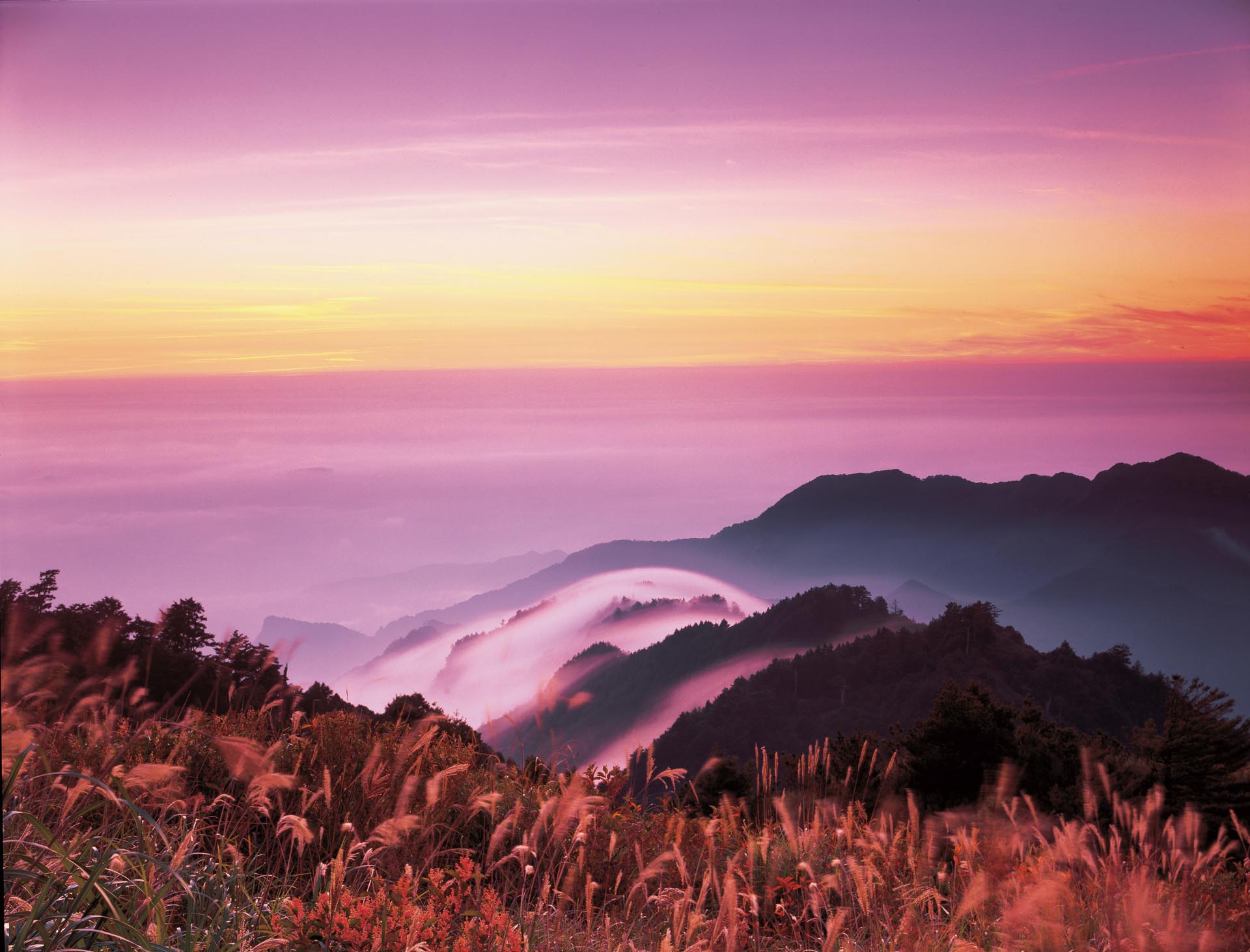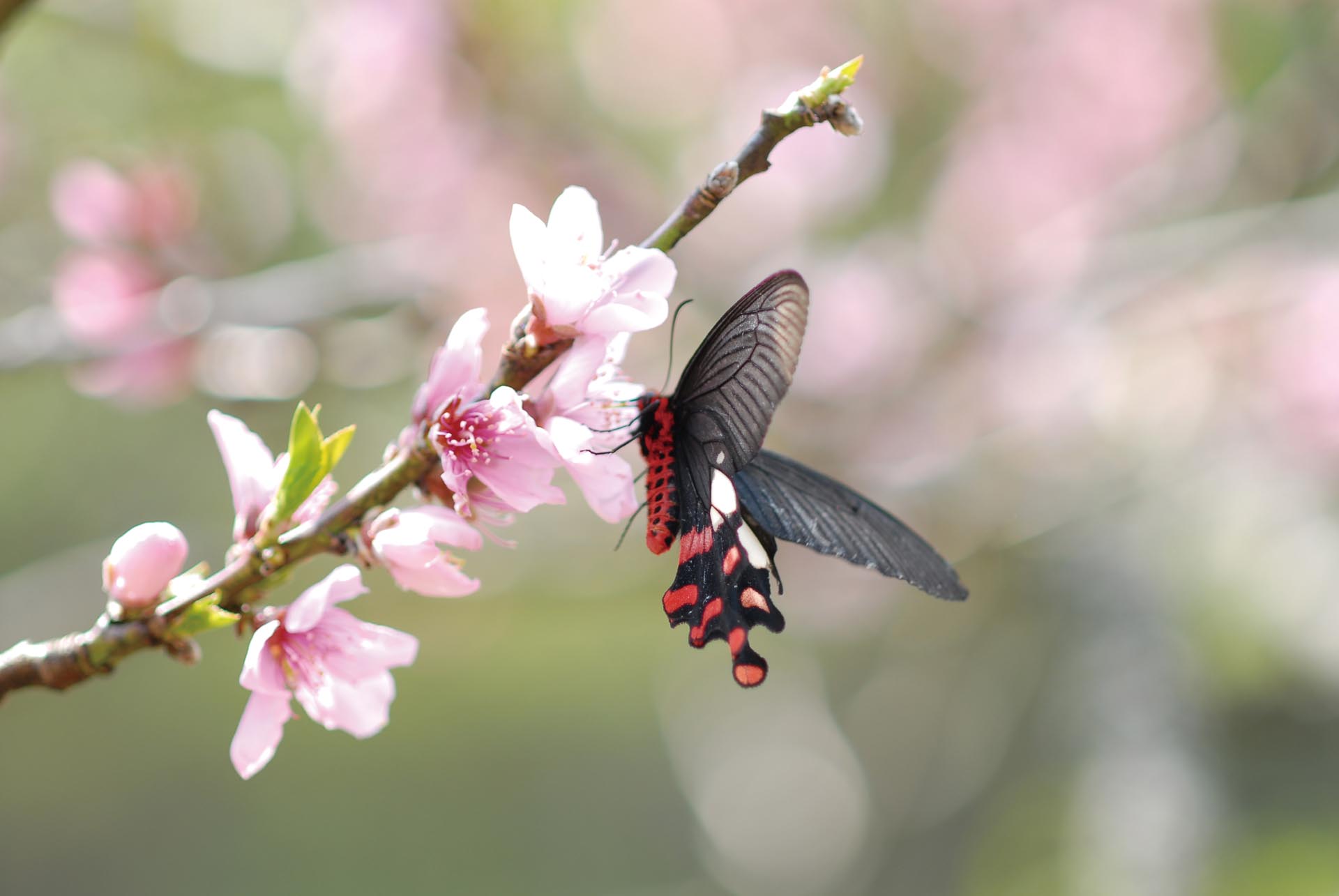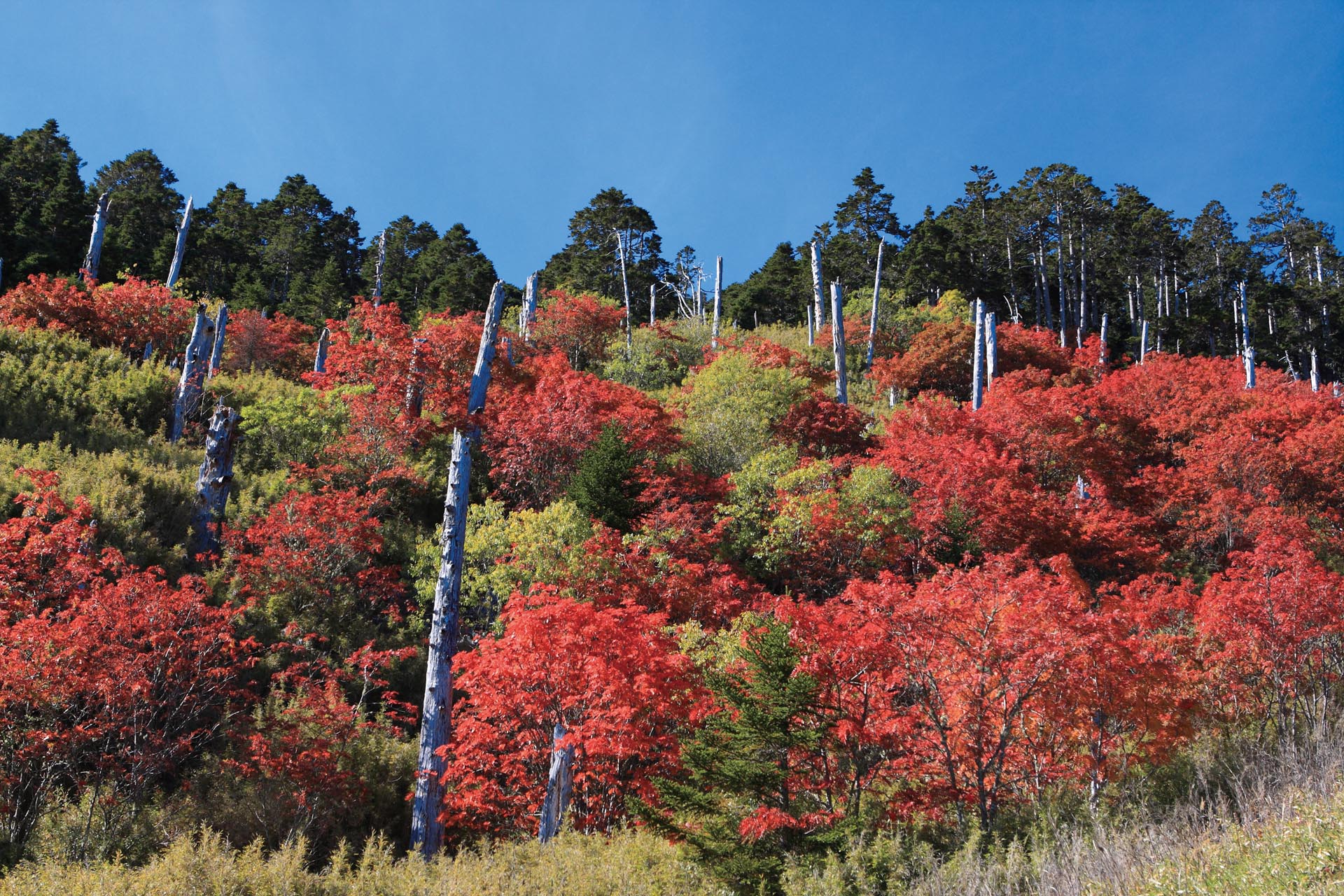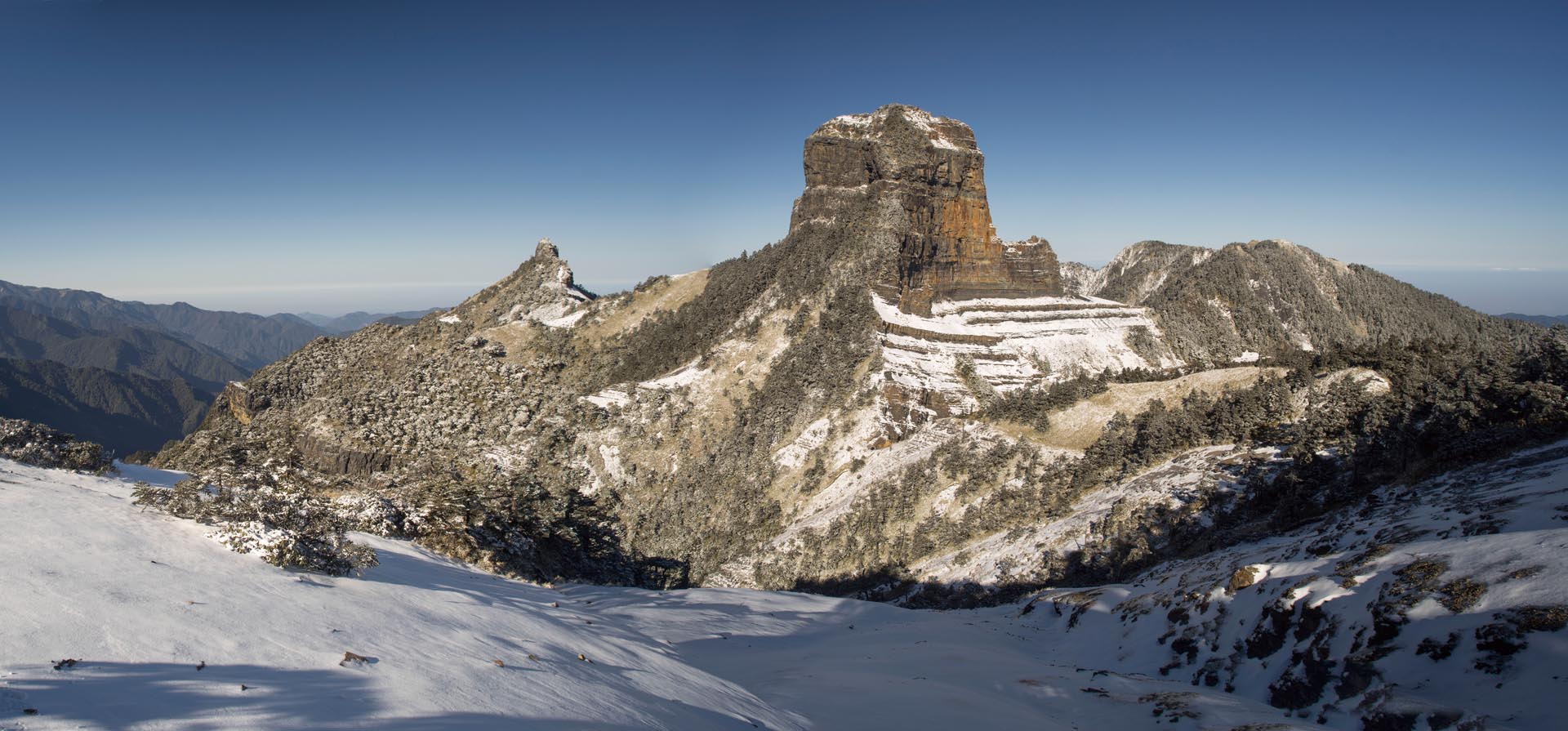When we are trying to gain some understanding of any national park, it is useful to consider in what country and what area the park lies. Shei-Pa National Park is in Taiwan, so a quick review of Taiwan may be helpful here.
Taiwan, or Formosa as it used to be called, is an island about 160 kilometers off the southeast coast of Mainland China, between Japan and Philippines on a line running north-southwest. It is approximately 36,000 square kilometers in size, about the same size as Holland, and a little larger than Massachusetts and Connecticut States combined. Three quarters of the land area is mountainous, much of it too steep to be cultivated easily. There are more than 200 peaks over 3,000 meters in altitude. The highest of them, Jade Mountain reaches 3,952 meters.
 The location of Taiwan
The location of Taiwan The Distribution of National Parks in Taiwan
The Distribution of National Parks in Taiwan Seas of clouds and beautiful sunsets attract visitors to the park.
Seas of clouds and beautiful sunsets attract visitors to the park.The climate is subtropical, and rainfall is heavy: average annual rainfall in the north is 100 inches (2,540 mm).
The population now numbers 23 million, mainly ethnic Chinese, but including also more than 300,000 aborigines of south Pacific ancestry, languages and culture. The people live mostly on the level plains, where the population density is very high. Taiwan has changed from an agricultural to a predominantly industrial society. Taiwan, with its warm climate, abundant rainfall, steep mountains and valleys, is rich in natural resources co-existing in a delicate equilibrium. This equilibrium is particularly threatened in two ways: firstly, owing to the steepness of the slopes and the force of the rainfalls, the forest cover is essential to prevent erosion, with loss both of soil and of water.
Secondly, the rapid development of human life causes many kinds of disturbance to the ecology, with the danger that today's advantages might be at the expense of man's future. This situation gives a particular urgency to the work of the national parks: to prevent certain chosen parts of the country from being overwhelmed by industrial growth; to provide areas where people can get recreation and exercise in contact with nature; and, especially important in a rapidly developing country, teach visitors to the park how to enjoy, understand and protect the wild life around them.
 Common Rose, a swallowtail butterfly, is easy to be found in the mountainous areas.
Common Rose, a swallowtail butterfly, is easy to be found in the mountainous areas. In autumn, the leaves of Taiwan Mountain Ash turning from green to red attract people to the high mountains.
In autumn, the leaves of Taiwan Mountain Ash turning from green to red attract people to the high mountains.NATIONAL PARKS OF TAIWAN
Most national parks, as well as working for these general aims, also have their own specific character and related aims, and this is true of the nine parks now established in Taiwan. (See table)
Table giving brief description of the nine national parks of Taiwan
| Region | Name of National Park | Important resources for conservation | Area in hectares | Date:
Plan announced publicly.
H.Q. set up |
|---|
| South | Kenting National Park | Raised coral reefs
Coastal forest
Tropical monsoon forest
Prehistorical remains
Maritime ecology | 18,083.5 (inland)
15,206.09(coastal)
33,289.59(total) | 1 Sept. 1982
1 Jan. 1984 |
| Central | Yushan National Park | High mountain topography
High mountain ecology
Spectacular peaks
Variety of forest types
Abundant animal life
Remains of old road | 103,121.4 | 6 April 1985
10 April 1985 |
| North | Yangmingshan National Park | Volcanic geology
Hot springs
Waterfalls
Grassland
Broad-leaved forest
Butterflies | 11,338 | Sept. 1985
16 Sept. 1985 |
| East | Taroko National Park | Marble gorge
Scarp cliff along fault line
Fold
Variety of forest types
Rich animal life
Remains of old road | 92,000 | Nov. 1985
28 Nov. 198 |
| Central | Shei-Pa National Park | High mountain ecology, geology, topography
Rivers and creek valleys
Rare animals and plants
Plentiful variety of forest types | 76,850 | 1 July 1992
1 July 1992 |
| Not on Taiwan | Island Kinmen National Park | Battlefield memories
Traditional villages
Pools and marshes
Coastal topography
Coastal forms of animal and plant life | 3,528.74 | 18 Aug. 1995
18 Aug. 1995 |
| Not on Taiwan | Island Dongsha Atoll National Park | High biodiversity of coral reef ecosystem
Marine culture and history
Complete and distinctive atoll terrain | 168.97(inland)
353,498.98(coastal)
353,667.95 (total) | 17 Jan. 2007
4 Oct. 2007
(overseen by Marine National Park Headquarters ) |
| South | Taijiang National Park | Wetlands ecology
Tidal land and sandbanks
Historic navigation channels
Salt industry and other special sights | 4,905(inland)
34,405(coastal)
39,310 (total) | 28 Sept. 2009
28 Dec. 2009 |
| Not on Taiwan | Island South Penghu Marine National Park | Basalt volcanic landscape
Historical and cultural sites
High biodiversity of coral reef ecosystem | 370.29(inland)
34,473.33(coastal)
35,843.62 (total) | 8 June 2014
4 Oct. 2007
(overseen by Marine National Park Headquarters ) |
| Total area | | | 311,498.15(inland)
438,573.80(coastal)
750,071.95 (total) | The total inland area is 8.63% of whole Taiwan island |
 Dabajian Mountain is Shei-Pa National Park's landmark and the foremost of 'Taiwan Triple Sharp Mountains'. It is also worshiped as a holy mountain for Atayal people.
Dabajian Mountain is Shei-Pa National Park's landmark and the foremost of 'Taiwan Triple Sharp Mountains'. It is also worshiped as a holy mountain for Atayal people.Shei-Pa National Park covers an area of 76,850 hectares on the central Taiwan range, slightly to the north of central Taiwan. This is a region of magnificent mountains: within the park are 51 peaks over 3,000 meters high. It is a mostly wild and undeveloped area with a range of wildlife that includes many rare and endemic species. The park was founded to protect and study this splendid wilderness, maintaining the natural environment and all forms of life it includes. Conservation is therefore the first priority for Shei-Pa National Park, and a large proportion of its land is protected as conservation area. (See ground plan)
GROUND PLAN OF SHEI-PA NATIONAL PARK
Under the National Parks Law, the parks are required actively to promote resource conservation, research, recreation and sustainability of use. To further the attainment of these ends, Shei-Pa National Park is divided into five types of management zone, with different levels of restriction and control over land use:
Conservation Area
Natural biotic communities and their habitats, which are strictly protected for ecological research. The unauthorized collection of specimens, the use of pesticides, and construction of any kind are forbidden.
Special Scenic Area
Areas of special natural features which could not be recreated, and in which development must be strictly controlled.
Recreation Area
Areas suitable for various outdoor leisure activities. The construction of recreational facilities and limited exploitation are permitted. The areas of this type are the Wuling, Guanwu, and Syuejian Recreation Areas.
General Protection Area
Areas of land and water not within other zone types, including existing small villages. Continuation of existing land use modes is permitted.
Historical Preservation Area
Areas placed under control to preserve important historical buildings, memorable sites, settlements, historical monuments, ruins, cultural landscapes, relics, as well as recognized ancestral graves, sites of worship, sites of origins, old tribal land, ruins, and historical monuments of the indigenous peoples and preserved in accordance with the indigenous cultures and customs.